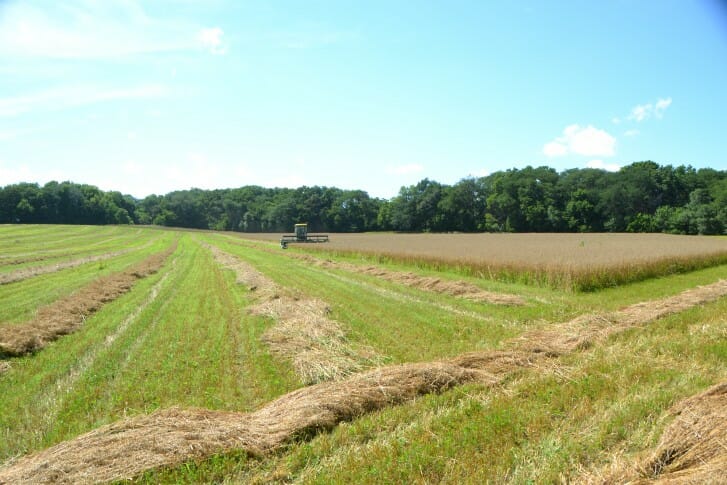Doing the Math and Picking a Market for Straw Profitability
One of the benefits of small grains is that they are very versatile crops. As we discussed in our previous blog about variety selection, a farmer can have many different end uses in mind when planting a small grain. One of the uses is to bale the straw for sale or for their own use. On our Feb 3 shared learning call, Extension educator and farmer Margaret Smith talked us through the costs of baling straw and market outlets for this product, advising that you have to do your math homework to see if it will fit in your business plan.

Oat straw windrows at harvest on the Fleishman’s farm in 2016
There are three main costs involved in baling straw. The labor and equipment costs are the biggest line items, but — Margaret cautions — don’t forget that by removing straw you’re taking nutrients off the field. Straw yields vary, but we’ll use a typical yield of 1 ton/A for the following discussion. The current cost to replace macro-nutrients removed in a ton of straw is $9 for potassium (K) and $2.20 for phosphorus (P). In addition, carbon is lost from the system (800 lbs C/ton of straw) limiting potential positive impact on soil organic matter, though this aspect of soil health has no immediate, out-of-pocket dollar value. She estimates the costs per ton per acre for custom baling range from $67 to $77, but only about $60 if you own the equipment and are baling yourself, as shown in the table below.
|
Custom Baling/ton |
Baling w/ farmer’s equipment/ton |
||||
|
Type of bale |
|||||
|
Sm Sq. |
Lrg. Sq. | Lrg. Rd. | Machinery |
Labor |
|
| Straw Baling |
$40 |
$53 | $53 | $21.50 |
$26 |
| Move from field to storage |
$20 |
$13 | $13 |
included in baling charges (above) |
|
| Nutrient replacement cost (P and K) |
$11 |
$11 | $11 |
$11 |
|
| Transport to sale |
varies |
varies |
|||
|
Total |
$67+ | $77+ | $77+ |
$58.50+ |
|
+ Plus the cost of transporting bales to sale
The profit margin for oat straw depends largely on where it’s sold. In general, selling to a local farm supply or directly to individuals brings a higher price than selling via a livestock or hay auction. Prices per 35 pound small square bale through direct or local sales are $3-5 per bale. That’s $170-285 per ton, leaving a nice profit margin even if you’ve hired the more expensive custom baling. However, marketing is more labor intensive because it caters to many small lot buyers which involve more advertising, arranging sales with customers and transporting bales/arranging pick-up. Selling through a hay auction, like the one in Fort Atkinson, brings in about $60-80/ton for large squares or large round bales. If we think back to the custom baling costs of $67-77/ton, plus the cost of transporting that straw to the auction, there’s a very slim margin for profit and some risk of loss. So, selling direct or locally is the safer option if you are having straw custom baled.
One final point to consider is that removing straw may not always be compatible with NRCS cost-share programs for small grains because of nutrient loss and potential loss of erosion control. Compatibility is determined on a case-by-case basis with your NRCS office, so, if NRCS cost-share is factoring into your profitability on small grain acres, check-in with your NRCS officer before baling.
The next shared learning call will address Best Management Practices for growing small grains on March 10 from 12:00-1:00 PM. Email alisha@practicalfarmers.org if you’re interested in joining the call and check out our Rotationally Raised video series on PFI’s youtube page. For more information on growing small grains, visit our small grains resource page.

Baling at the Dahl farm in 2009

